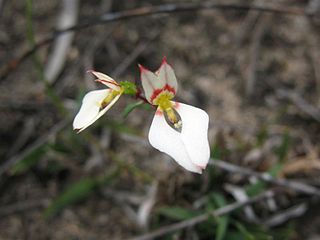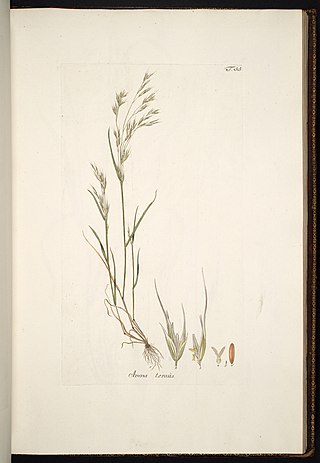
Bellis is a genus of flowering plants in the family Asteraceae.

Fumaria is a genus of about 60 species of annual flowering plants in the family Papaveraceae. The genus is native to Europe, Africa and Asia, most diverse in the Mediterranean region, and introduced to North, South America and Australia. Fumaria species are sometimes used in herbal medicine. Fumaria indica contains the alkaloids fuyuziphine and alpha-hydrastine. Fumaria indica may have anti-inflammatory and analgesic potential.

Gnaphalium is a genus of flowering plants in the family Asteraceae, commonly called cudweeds or (formerly) chafeweeds. They are widespread and common in temperate regions, although some are found on tropical mountains or in the subtropical regions of the world.

Nepenthes dubia is a tropical pitcher plant endemic to the Indonesian island of Sumatra, where it grows at an altitude of 1600–2700 m above sea level. The specific epithet dubia is the Latin word for "doubtful".

Nepenthes tenuis is a tropical pitcher plant endemic to the Indonesian island of Sumatra. The species was first collected in 1957, from a remote mountain in the western part of the island. It remained undescribed until 1994, and was only rediscovered in the wild in 2002. Prior to this, N. tenuis was known solely from a single photograph and dried herbarium specimen.

The Cardueae are a tribe of flowering plants in the daisy family (Asteraceae) and the subfamily Carduoideae. Most of them are commonly known as thistles; four of the best known genera are Carduus, Cynara, Cirsium, and Onopordum.

Clausilia dubia is a species of small, very elongate, left-handed air-breathing land snail, a sinistral terrestrial pulmonate gastropod mollusk in the family Clausiliidae, the door snails, all of which have a clausilium.

Levenhookia, also known as the styleworts, is a genus of ten recognized species in the family Stylidiaceae and is endemic to Australia. The genus is restricted to Western Australia almost exclusively with a few exceptions: L. pusilla's range extends into South Australia, L. dubia's range extends through South Australia into Victoria and New South Wales, L. sonderi is native only to Victoria, and L. chippendalei is also found in the Northern Territory.

Levenhookia dubia, the hairy stylewort, is a dicotyledonous plant that belongs to the genus Levenhookia. It is an ephemeral annual that grows from 2–6 centimetres (0.79–2.36 in) tall with obovate leaves that are generally 2–5 millimetres (0.079–0.197 in) long. Flowers are white and bloom from September to October in its native range. L. dubia is most closely related to L. sonderi, which has been described as a variety of L. dubia in the past. It is endemic to Australia and has native ranges in Western Australia, South Australia, New South Wales, and Victoria. Its habitat has been reported as being sandy soils in granite outcrops.

The white-faced darter or small whiteface is a dragonfly belonging to the genus Leucorrhinia in the family Libellulidae, characterised by red and black markings and a distinctive white patch on the head. It is found in wetlands and peat bogs from northern Europe eastwards to Siberia, and the adults are active from around April till September, which is known as the "flight period". It breeds in acidic bodies of water, laying its eggs in clumps of sphagnum moss that provide a safe habitat for larval development. The larvae are particularly vulnerable to predation by fish, and so are usually found in lakes where fish are not present. L. dubia is listed as a species of least concern (LC) by the IUCN Red List, however, it is potentially threatened by habitat destruction, pollution, and climate change.

Ventenata is a genus of plants in the grass family, native to Europe, North Africa, and central + southwest Asia. One species, Ventenata dubia, is considered an invasive weed in many places.
Dubia is a plural of the Latin word dubium and may refer to:
Coleophora staehelinella is a moth of the family Coleophoridae. It is found in southern France and Spain.
Calyciphora adamas is a species of moth from the Pterophoridae family. It is found in Portugal, Spain, southern France and Italy.

Libinia dubia, the longnose spider crab, is a species of crab in the family Epialtidae. It is found in shallow waters on the eastern coast of North America.
Bucculatrix alpina is a moth in the family Bucculatricidae. The species was first described by Heinrich Frey in 1870. It is found in southern France, Switzerland, Austria and Italy.
Gagea dubia is a Mediterranean species of plants in the lily family. It is native to Morocco, Spain, France, Sardinia, Sicily, Greece including Crete, Turkey, Syria, Lebanon, and Iran.
Scrobipalpa suasella is a moth in the family Gelechiidae. It was described by Constant in 1895. It is found in southern France, Portugal, and Spain, as well as on Sardinia.
Facelina dubia is a species of sea slug, an aeolid nudibranch, a marine gastropod mollusc in the family Facelinidae.












